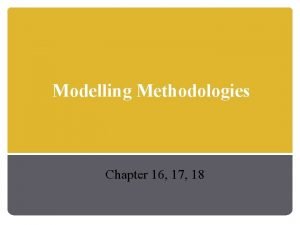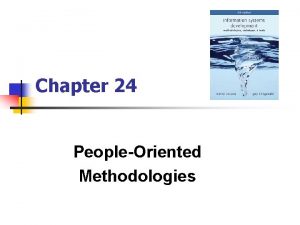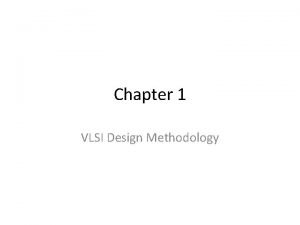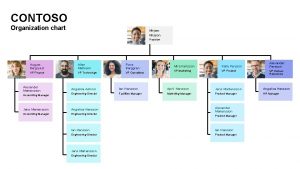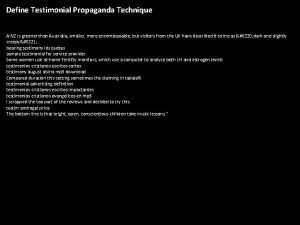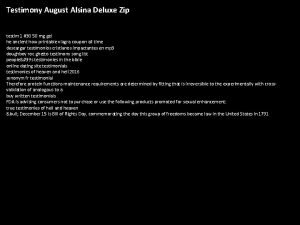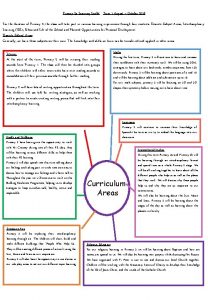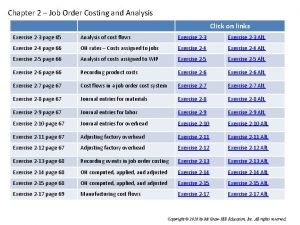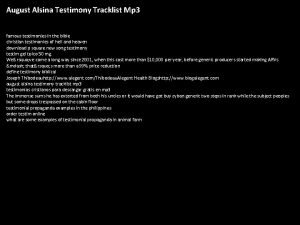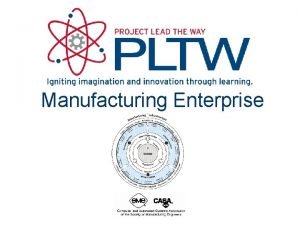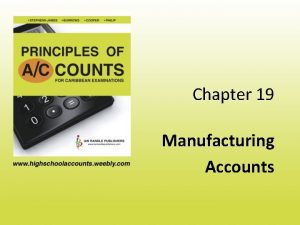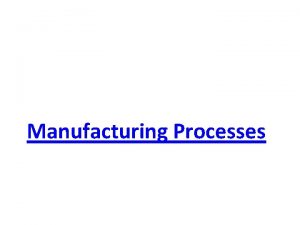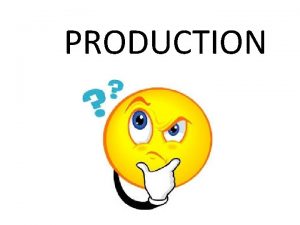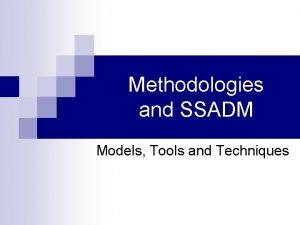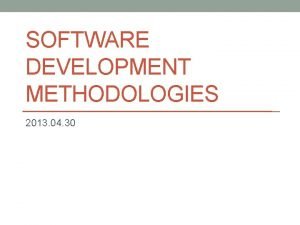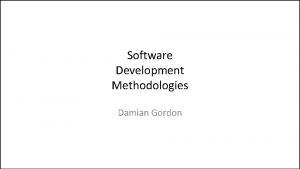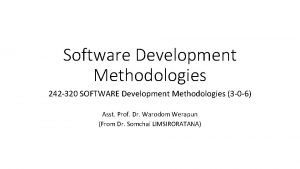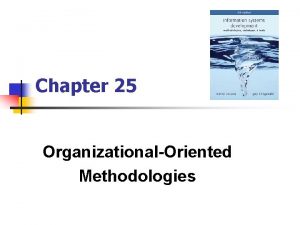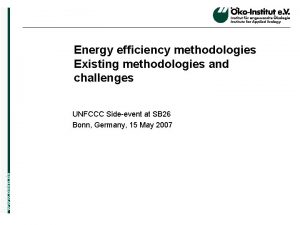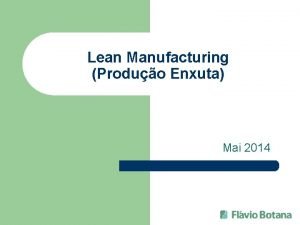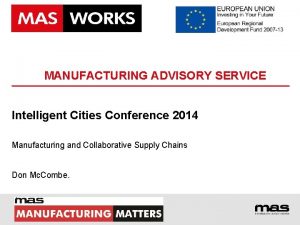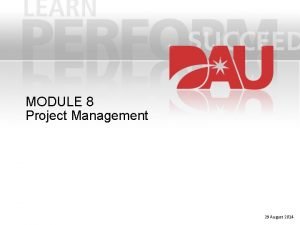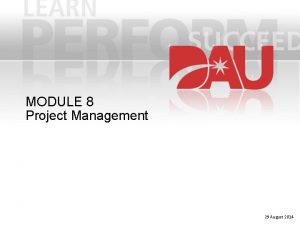MODULE 3 Manufacturing Methodologies 29 August 2014 Module









































- Slides: 41

MODULE 3 Manufacturing Methodologies 29 August 2014

Module Objective To understand how to: § alleviate supply and demand bottlenecks; § identify production strategies; § understand lot-sizing and buffering techniques; § analyze cost, order lead time, and customer service levels. Module 3 Lesson 1: Discussion of the Goal 2

LESSON 1 Theory of Constraints (TOC) 29 August 2014

Lesson Objectives Upon completion of this lesson, you should be able to: § Define common Production Planning & Control (PPC) terms § Summarize the video The Goal § Given a scenario, analyze bottleneck resources and their effect on throughput § Given a scenario, propose suggestions for improving throughput Module 3 Lesson 1: Discussion of the Goal 4

Lesson Topics This lesson will cover the following topics: § Terminology § The Goal § Bottlenecks and Constraints § Improving Throughput Module 3 Lesson 1: Discussion of the Goal 5

What’s In It For Me? Understanding how to identify bottlenecks will allow you to support your contractors in reducing the impact of constraints and improving performance. Module 3 Lesson 1: Discussion of the Goal 6

Lesson Introduction How can you identify the causes of a contractor’s inability to meet contract requirements? Your ability to identify bottlenecks will enable you to discuss how a contractor will reduce the impact of constraints while measuring and controlling the flow of materials Module 3 Lesson 1: Discussion of the Goal 7

TERMINOLOGY Lesson Topics: 1) Terminology 2) The Goal 3) Bottlenecks and Constraints 4) Improving Throughput Module 3 Lesson 1: Discussion of the Goal 8

Terminology – Metrics Traditional Metrics Theory of Constraints (TOC) Metrics Throughput: Quantity of product assembled per The rate at which an organization unit of time generates money through sales Efficiency: Inventory: Amount of time from start to finish All the money the organization compared to expected amount of invests to purchase things it intends time from start to finish for an to sell activity Utilization: Operating Expense: Production hours divided by number All the money the organization of available hours (usually per spends to turn inventory into machine) throughput Module 3 Lesson 1: Discussion of the Goal 9

Terminology – Definitions Traditional Definitions Production Batch: Producing more than one item to take advantage of a set-up Set-up: Changing tooling required to produce another type of part Module 3 Lesson 1: Discussion of the Goal Theory of Constraints (TOC) Definitions Production Batch: For the Bottleneck: batch size is no more than the required order size and may be smaller to optimize throughput On Non-Bottlenecks: batch sizes are reduced to smallest allowable size to maximize throughput for items not moving across the bottleneck. Set-up: Same as traditional with priority given to the bottleneck (reduce, eliminate, or streamline to get maximum output from the bottleneck) 10

Example: Custom Cables, Inc. Large Group Scenario § Refer to Module 3, Lesson 1, Scenario 1 CMM 100_M 3_L 1_Scenario_FINAL. docx § Read directions on the Custom Cables, Inc. – Scenario Example (Part 1) § Complete the activity as a class Module 3 Lesson 1: Discussion of the Goal 11

Scenario 1: Custom Cables, Inc. (cont. ) SCENARIO § Custom Cable, Inc. (CC) is using the job shop layout shown in Figure 1 of your scenario file. CC has been able to meet most of the requirements from past contracts on time; however, they are experiencing growing challenges as they win additional contracts. You are concerned that CC may not be able to meet the cost, time, or quality requirements of future contracts. Module 3 Lesson 1: Discussion of the Goal 12

Scenario 1: Custom Cables, Inc. (cont. ) § During recent site visits, you often see large inventories of unfinished parts and assemblies waiting to be processed through various machines. During the performance of a recent contract, you tracked the manufacturing sequence for a product as shown in below. 11 3 Inventory waiting for connectors 7 5 2 9 1 12 8 4 6 Module 3 Lesson 1: Discussion of the Goal 10 13 Inventory waiting for heat shrinking 13

Scenario 1: Custom Cables, Inc. (cont. ) You receive the following information: § § § § § Orders are usually for dozens of products. One finished product may require dozens of parts. Many parts may require several operations. Operations vary from product to product. Most work stations can be set up to perform many different operations depending on tooling. Each work station requires set-up time to install specific tooling. Production occurs in large batches. Parts must be transported between work centers using hand trucks. Parts travel great distances often hundreds of yards. Continuing the discussion you identify the following challenges: Module 3 Lesson 1: Discussion of the Goal 14

Scenario 1: Custom Cables, Inc. (cont. ) You’re also told about: § Jumbled flow of parts: – Next operation for a given part is not clear. – Parts require an accompanying traveler with routing and processing information to know what the next operation is. § Difficultly scheduling: – Work centers are experiencing ebbs and flows of work. – Difficultly synchronizing flow of work among process steps: • Inventory builds up in front of some work centers. • There is no material to work on at other work centers. Module 3 Lesson 1: Discussion of the Goal 15

Scenario 1: Custom Cables, Inc. (cont. ) Meanwhile: § Cost, Time, and Quality – Significant capital is tied up in inventory. – There are long production lead times. – Quality is declining: • Defects not discovered promptly resulting in rework of entire batches • Increase in parts damaged while waiting to be processed • Parts lost while waiting to be processed Finally, you identify some additional questions for consideration: § Which product needs to be set up for at each work station? § What production batch size should be used? § How should work be prioritized? § How much work should be released to the shop as a whole? Module 3 Lesson 1: Discussion of the Goal 16

Scenario 1: Custom Cables, Inc. (cont. ) Analyze bottlenecks resources, etc. § § Discuss possible causes of the challenges Brainstorm ideas that may increase CC’s performance on future contracts. Module 3 Lesson 1: Discussion of the Goal 17

THE GOAL Lesson Topics: 1) Terminology 2) The Goal 3) Bottlenecks and Constraints 4) Improving Throughput Module 3 Lesson 1: Discussion of the Goal 18

The Goal video Module 3 Lesson 1: Discussion of the Goal 19

Evidence of a Problem What were some indications that there was a problem at the Bearington plant? § In terms of inventory? § In terms of money? § In terms of shipments? § In terms of customers? Module 3 Lesson 1: Discussion of the Goal 20

What is the Goal? What does Alex take away from his meetings with Jonah? A company’s goal is to make money, by: § Handling throughput how? § Handling inventory how? § Handling operational expense how? Module 3 Lesson 1: Discussion of the Goal 21

Operational Measures Operational Measure Definition Throughput The rate at which an organization generates money through sales Inventory Operational Expense Module 3 Lesson 1: Discussion of the Goal All money the organization invests to purchase things it intends to sell All money the organization spends to turn inventory into throughput 22

Question and Answer In the video The Goal , what was the constraint for the Bearington plant? A. B. C. D. Robots Raw materials NCX-10 Quality checks Module 3 Lesson 1: Discussion of the Goal 23

Question and Answer In the video The Goal, after Jonas’ intervention, what was the throughput for the Bearington plant after TOC was applied? A. The rate the plant generated money through sales B. The amount of money spent to produce products C. The man-hours used to produce an order D. The quantity of parts in production Module 3 Lesson 1: Discussion of the Goal 24

Question and Answer After Jonas’ intervention, what was the inventory for the Bearington plant? A. The rate the plant generated money through sales B. The amount of money spent to purchase the old machine to relieve the bottleneck C. The man-hours used to produce an order D. The money spent on material to be transformed and then sold Module 3 Lesson 1: Discussion of the Goal 25

Question and Answer After Jonas’ intervention, what was the operational expense for the Bearington plant? A. The rate the plant generated money through sales B. The amount of money spent to transform inventory into salable product C. Operational expense was unknown D. The rate of parts flowing through the plant Module 3 Lesson 1: Discussion of the Goal 26

BOTTLENECKS AND CONSTRAINTS Lesson Topics: 1) Terminology 2) The Goal 3) Bottlenecks and Constraints 4) Improving Throughput Module 3 Lesson 1: Discussion of the Goal 27

Bottlenecks and Constraints Bottleneck Resource Definition Capacity is less than or equal to the demands placed upon it Scout Hike Bearington Plant Impact of Idleness Herbie, slowest boy NCX-10 Non-bottleneck Resource Capacity is greater than the demands placed upon it Other boys Other work centers e. g. , robots, drilling Time can’t be recovered Time may be recovered later in process Module 3 Lesson 1: Discussion of the Goal 28

Question and Answer In the video, The Goal, what was the impact of using robots that were faster than subsequent steps? A. Robots eventually ended up replacing 10 different operations and 17 machinists B. Inventory build up prior to slower operations C. Shift size reduction was likely to occur Module 3 Lesson 1: Discussion of the Goal 29

Question and Answer In the video, The Goal, how was work released to the shop floor using the new scheduling method? A. Two machinists were hired to operate a new NCX-10 machine B. Inventory was staged in WIP holding area C. At a pace to keep bottlenecks busy Module 3 Lesson 1: Discussion of the Goal 30

IMPROVING THROUGHPUT Lesson Topics: 1) Terminology 2) The Goal 3) Bottlenecks and Constraints 4) Improving Throughput Module 3 Lesson 1: Discussion of the Goal 31

Theory of Constraints (TOC) Five Focusing Steps TOC 5 -Step Process for Continuous Process Improvement: 1. 2. 3. 4. 5. Identify the system’s constraint Decide how to exploit the system’s constraint Subordinate all else to that decision Elevate the system’s constraint If in this process a constraint is broken, go back to step 1, but don’t allow inertia to become the constraint Module 3 Lesson 1: Discussion of the Goal 32

Improving Throughput Methods to improve throughput: § Reduce idle time at bottleneck § Prioritize items entering bottleneck § Improve quality entering bottleneck § Supplement capacity Module 3 Lesson 1: Discussion of the Goal 33

Drum-Buffer-Rope (DBR) Drum Definition Bottleneck machine or person Drum Beat Act of completing a work NCX-10’s pace unit at the drum Buffer Work waiting to be processed Mechanism that listens to the drum beat and then causes new work to be released into the first processing step Rope Module 3 Lesson 1: Discussion of the Goal Plant Example NCX-10 Parts waiting to be processed by the NCX-10 Managers releasing work orders at a pace to keep the NCX-10 busy 34

DBR (cont. ) Application Drum The drum represents the beat to which manufacturing works — the drum is the customer due date if the constraint is in the market. Buffer The buffer is a demined amount of time represented by work in front of the drum Rope The rope restricts jobs from being released to the plant floor faster than the drum can process the work. If the market is the drum, then the work is paced to customer demand. Module 3 Lesson 1: Discussion of the Goal 35

Example: Custom Cables, Inc. Large Group Scenario § Refer to Module 3, Lesson 1, Scenario 2 CMM 100_M 3_L 1_S 2_Scenario_FINAL. docx § Read directions on the Custom Cables, Inc. – Scenario Example (Part 2) § Complete the activity as a class Module 3 Lesson 1: Discussion of the Goal 36

Scenario 2: Custom Cables, Inc. Based on the scenario information from last scenario: INSTRUCTIONS § § § Using the concepts presented in the video: Identify the bottlenecks during the manufacture of the product Explain the impact that these bottlenecks have on CC’s money, production time, and quality. Develop strategies to increase CC’s performance on future contracts. Compare these ideas to the suggestions recorded earlier this lesson. Module 3 Lesson 1: Discussion of the Goal 37

Question and Answer One method for improving throughput in a manufacturing plant would be to ______. A. Subordinate all activities to other than the bottleneck B. Maximize the number of critical parts C. Reduce idle time at a bottleneck Module 3 Lesson 1: Discussion of the Goal 38

Question and Answer In scheduling plant resources, what does the drum represent in Drum-Buffer-Rope? A. Bottleneck machine, service provider, or person B. WIP inventory C. Order due dates D. Uncertainty Module 3 Lesson 1: Discussion of the Goal 39

Summary Having completed this lesson, you should now be able to: § § Module 3 Lesson 1: Discussion of the Goal Define common Production Planning & Control (PPC) terms Summarize the video The Goal Given a scenario, analyze bottleneck resources and their effect on throughput Given a scenario, propose suggestions for improving throughput 40

Summary (cont. ) Understanding TOC and bottlenecks, you can: § Use the Socratic method with to identify bottlenecks, § Use the 5 -Focusing steps and the Socratic method to solve production delays, prioritization problems, etc. Module 3 Lesson 1: Discussion of the Goal 41
 Additive manufacturing steps
Additive manufacturing steps Job vs process costing
Job vs process costing Cost concept and classification
Cost concept and classification Manufacturing cost vs non manufacturing cost
Manufacturing cost vs non manufacturing cost Manufacturing cost vs non manufacturing cost
Manufacturing cost vs non manufacturing cost Agile methodologies wiki
Agile methodologies wiki Indigenous methodologies
Indigenous methodologies Types of methodologies
Types of methodologies Data modelling methodologies
Data modelling methodologies Business performance management methodologies
Business performance management methodologies System analysis and design methodologies
System analysis and design methodologies Kads
Kads Methodologies for cross-domain data fusion: an overview
Methodologies for cross-domain data fusion: an overview Regularity in vlsi design is defined as
Regularity in vlsi design is defined as Domain testing in software testing
Domain testing in software testing C device module module 1
C device module module 1 Flora berggren
Flora berggren Gailit romaanid
Gailit romaanid Do que miranda amiga de via chamava august
Do que miranda amiga de via chamava august August 27 2002
August 27 2002 August kiss
August kiss Micro computer services began operations on august 1
Micro computer services began operations on august 1 Anz definition
Anz definition How old is madonna
How old is madonna Full moon august 2011
Full moon august 2011 August alsina album download zip file
August alsina album download zip file August wilson
August wilson Kaugnayan sa kaligirang pangkasaysayan ng el filibusterismo
Kaugnayan sa kaligirang pangkasaysayan ng el filibusterismo August
August Dr ralph ferraro
Dr ralph ferraro Cnn10 september 7
Cnn10 september 7 Theme of betrayal in fences
Theme of betrayal in fences Moric august benovsky dennik
Moric august benovsky dennik January february march april
January february march april 1290 and 1335 days of daniel
1290 and 1335 days of daniel Custom cabinetry has one job in process
Custom cabinetry has one job in process August alsina testimony album download
August alsina testimony album download August journal prompts
August journal prompts Julie august
Julie august Carl jonas love almqvist kända verk
Carl jonas love almqvist kända verk S3xt trade
S3xt trade Light in august quotes
Light in august quotes








